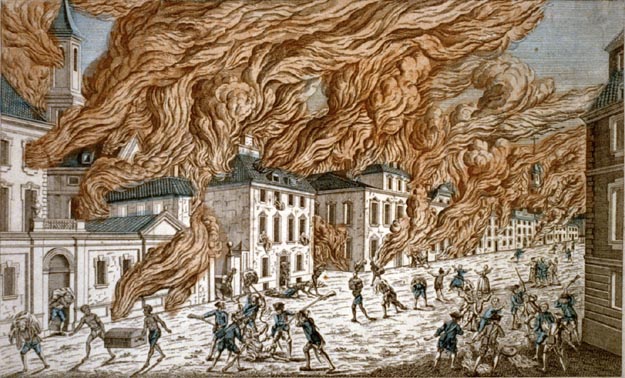New York Negro Insurrections
|
|
This Site:
|
Alleged New York Negro InsurrectionsNew York Colony - Fear of Negro Insurrections - New York Riots of 1765 - The Fields of New York - The Eve of Revolution in New York - Capture of New York - Great New York Fire of 1776 - Evacuation of New York in 1783 New York in the Civil War - The New York Draft Riots (1862) Alleged Negro Plots. - In 1712 the citizens of New York were disturbed by apprehensions of a conspiracy of their negro slaves to burn the city and destroy the inhabitants. The population then was about 6,000, composed largely of slaves. Nineteen of those suspected of the crime suffered. A more disastrous alarm about a plot of the negroes for destroying the city occurred in the spring and summer of 1741, when the population was about 10,000, one - fifth of whom were negro slaves. The most prominent merchants of the city were engaged in the slave-trade. Conscious of the natural aspirations of the human soul for personal freedom, very stringent rules had been adopted for the subordination of the slaves, and every transgression was severely punished. Every act of insubordination made the community tremble with fear of possible consequences, and this feeling of insecurity needed only a slight provocation to ripen into a general panic. A trifling robbery occurred in March, 1741, in the house of a merchant, which was traced to some negroes. Nine fires occurred in different parts of the city soon afterwards, and though most of them were merely the burning of chimneys, they produced terror. A general alarm was instantly created in the public mind. Numerous arrests were made and a searching investigation was instituted by the magistrates, but no trace of incendiarism could be found. Three heavy rewards were offered by the city authorities for the arrest and conviction of the perpetrators, and a full pardon to such of them as should reveal a knowledge of their crime and of their associates. An indentured servant-woman (Mary Burton) purchased her liberty and secured a reward of $500 by pretending to give information of a plot, formed by a low tavern-keeper and her master and three negroes, to burn the city and murder the white people. This story was confirmed by an Irish prostitute, convicted of a robbery, who, to recommend herself to mercy, turned informer. Many other arrests were now made among the slaves and free negroes. The Supreme Court of the province was specially convened for the investigation of the matter, and a grand jury, composed of some of the principal inhabitants of the city, held a solemn inquest. Other informers besides Mary Burton speedily appeared, and fresh victims were seized. The panic and fury among the population was fearful, and the authorities were stimulated thereby to hurried inquiries, unjust convictions, and the infliction of awful punishments on the innocent. The eight lawyers who then composed the bar of New York all assisted, by turns, in the prosecution. The negroes had no counsel, and were convicted and executed on insufficient evidence. The lawyers vied with each other in abusing the poor, terrified victims, and Chief-Justice De Lancey, in passing sentence, vied with the lawyers in this abuse. Many confessed to save their lives, and then accused others. John Ury, a school-master, and reputed Roman Catholic priest, was denounced by Mary Burton, and, not-withstanding his solemn protestations of innocence and the absence of competent testimony to convict him, he was hanged. His arrest was the signal for the arrest of other white people, and the reign of terror was fearfully intensified; but, when (as in the case of the Salem witchcraft excitement) Mary Burton accused prominent persons known to be innocent, the delusion instantly abated, the prisons were cleared of victims, and the public mind was calmed. From May 11 until August 29, 154 negroes were committed to prison, fourteen of whom were burned at the stake, eighteen hanged, and seventy-one transported. During the same period twenty-four white people were imprisoned, four of whom were hanged. There was no more foundation for this insane panic about a negro plot and its fearful consequences than there was for the witchcraft delusion and its' terrible results. See WITCHCRAFT. |
|
|
||
|
|
Site Copyright 2003-2018 Son of the South. For Questions or comments about this collection, contact: paul@sonofthesouth.net |
|
|
Are you Scared and Confused? Read My Snake Story, a story of hope and encouragement, to help you face your fears. |
||
